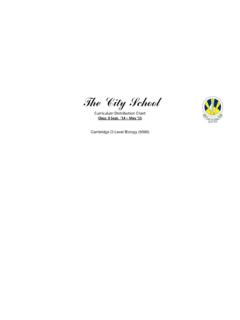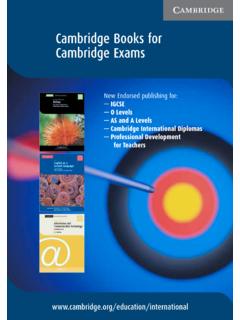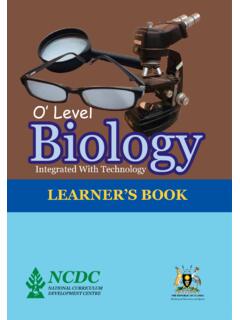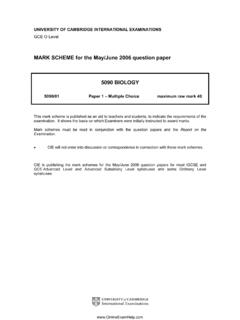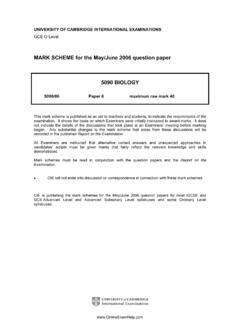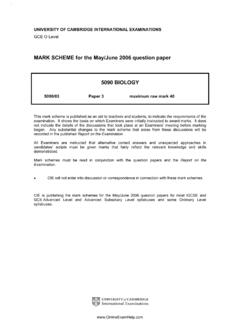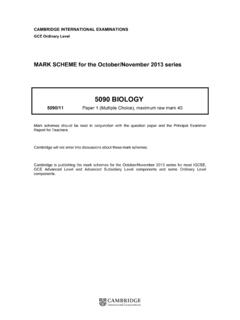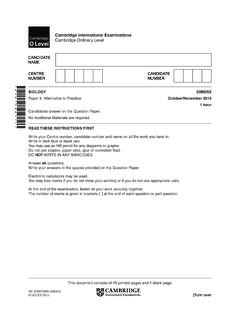Transcription of 11 5090 21 2014 77214 - Collection of O level and A/As ...
1 This document consists of 14 printed pages and 2 blank (LK/CGW) 77214 /4 UCLES 2014 [Turn overCambridge International ExaminationsCambridge Ordinary level *6419188534* biology 5090/21 Paper 2 Theory October/November 2014 1 hour 45 minutesCandidates answer on the Question Additional Materials are THESE INSTRUCTIONS FIRSTW rite your Centre number, candidate number and name on all the work you hand in dark blue or black may use an HB pencil for any diagrams or not use staples, paper clips, glue or correction NOT WRITE IN ANY AAnswer all your answers in the spaces provided on the Question BAnswer all your answers in the spaces provided on the Question CAnswer either question 8 or question your answers in the spaces provided on the Question are advised to spend no longer than one hour on Section calculators may be may lose marks if you do not show your working or if you do not use appropriate the end of the examination.]
2 Fasten all your work securely number of marks is given in brackets [ ] at the end of each question or part UCLES 2014 Section AAnswer all the questions in this your answers in the spaces Fig. shows a section through a plant organ with a very small pipette (micropipette) inserted into tissue A. AmicropipetteFig. (a) (i) Name the plant organ shown in Fig.. [1] (ii) Name the tissue labelled A.. [1] (b) The micropipette is used to take samples from tissue A at regular intervals over a 24-hour period. These samples are then analysed for their content. Explain how this might provide information about the rate of photosynthesis in the plant.. [4]35090/21/O/N/14 UCLES 2014 [Turn over (c) Some insects have mouthparts similar to the tube of the micropipette. Suggest reasons for these insects using tissue A to supply their food.]
3 [4] [Total: 10]45090/21/O/N/14 UCLES 20142 Fig. shows the digestion, absorption and assimilation of a chemical (B). It also shows the formation of its waste product, chemical F. chemicalDchemicalBcarbohydrateEstored inthe liverenzymeCalimentarycanalhepaticportal veinchemicalFexcretedvia thekidneysliver Fig. (a) Namechemical B ..enzyme C ..chemical D ..carbohydrate E ..chemical F .. [5] (b) (i) Describe what happens to carbohydrate E before it can be used in metabolic reactions in body cells.. [2] UCLES 2014 [Turn over (ii) Name the process in which the product of carbohydrate E is used within a body cell. process .. [1] (iii) Describe how different types of body cells and tissues make use of this process.. [4] [Total: 12]65090/21/O/N/14 UCLES 20143 (a) At puberty, hormones are produced that are responsible for the development of secondary sexual characteristics.]
4 (i) Name one secondary sexual characteristic in males.. [1] (ii) Name the hormone responsible for the development of secondary sexual characteristics in males.. [1] (iii) Name the organs that produce this hormone.. [1] (b) Fig. shows the concentrations in the blood of two hormones, F and G, involved in a woman s menstrual / weekshormoneG34hormoneFFig. (i) Name the hormones F and ..G .. [2] (ii) State what occurs at time H.. [1]75090/21/O/N/14 UCLES 2014 [Turn over (c) Fig. shows the thickness of the same woman s uterus lining over a 4-week period. thicknessof uteruslining0timeFig. The graph shown in Fig. does not begin at the same time as the cycle shown in Fig. Indicate on Fig. , with a line labelled J, the stage shown by line H on Fig.]
5 , and explain your reason for choosing this point on the graph.. [4] [Total: 10]85090/21/O/N/14 UCLES 20144 Fig. shows the effect of exercise on the concentration of oxygen in the blood and the concentration of lactic acid in the muscles of a healthy person over a 5-minute period. 1concentrationoxygenlactic acid20time / minutes345 Fig. (a) Use Fig. to find the time at which the person started to exercise.. [1] (b) Name the process that causes the change in oxygen concentration during the first 2 minutes on Fig.. [1] (c) Suggest and explain how each of the two curves on Fig. might be different if the person suffered from emphysema.. [5] [Total: 7]95090/21/O/N/14 UCLES 2014 [Turn over5 Fig. shows a decaying tooth. Karea ofdecayFig. (a) Name the type of tooth shown.. [1] (b) Name two structures that are found in region.]
6 2 .. [2] (c) Explain the causes of the decay shown in Fig.. [4]105090/21/O/N/14 UCLES 2014 (d) Two different regions were studied to see the effect of fluoridation of drinking water on the mean number of decayed teeth in children living in those regions. In region L, the percentage of children drinking fluoridated water gradually increased over a 30-year period. In region M, no fluoride was added to the drinking water over the same period. Table shows the mean number of decayed teeth per child in each region. It also shows the percentage of children drinking fluoridated water in region L. Table dateregion Lregion Mpercentagemean numbermean (i) State the effect of adding fluoride to the water supplies in region L.. [1] (ii) Suggest three possible reasons for the results shown for children in region.
7 2 ..3 .. [3] [Total: 11] 115090/21/O/N/14 UCLES 2014 [Turn overSection BAnswer both questions in this your answers in the spaces (a) Describe the two forms of variation found within a natural population.. [5] (b) Explain how variation is important for the long-term survival of the species.. [5] [Total: 10]125090/21/O/N/14 UCLES 20147 Describe the similarities and differences in structure and function of root hairs and villi. (a) similarities .. [4] (b) differences .. [6] [Total: 10]135090/21/O/N/14 UCLES 2014 [Turn overSection CAnswer either question 8 or question your answers in the spaces (a) (i) Explain how meiosis is involved in the formation of gametes.. [2] (ii) Explain how two plants, one with red flowers and one with white flowers, can produce seeds that will grow into plants with either red or white flowers in the ratio of 1:1.]]
8 [6] (b) Suggest how two plants, of a different species, one with red and one with white flowers, could produce seeds that will grow into plants with pink flowers.. [2] [Total: 10]145090/21/O/N/14 UCLES 20149 (a) Describe the path taken by a molecule of carbon dioxide, and the processes in which it is involved, from the moment it leaves the atmosphere until it forms part of a starch molecule in a leaf.. [7] (b) Explain how a lack of magnesium in the soil in which a plant is growing may reduce the formation of starch in a leaf.. [3] [Total: 10]155090/21/O/N/14 UCLES 2014 BLANK PAGE165090/21/O/N/14 UCLES 2014 Permission to reproduce items where third-party owned material protected by copyright is included has been sought and cleared where possible. Every reasonable effort has been made by the publisher (UCLES) to trace copyright holders, but if any items requiring clearance have unwittingly been included, the publisher will be pleased to make amends at the earliest possible International Examinations is part of the Cambridge Assessment Group.
9 Cambridge Assessment is the brand name of University of Cambridge Local Examinations Syndicate (UCLES), which is itself a department of the University of PAGE
